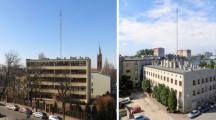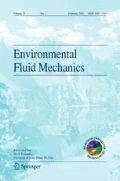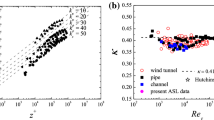Abstract
The spatial variability of flow and turbulence properties above an outdoor scale model of regular cube roughness under neutral stability is investigated using eight simultaneously employed sonic anemometers which are characterized by an extra short transducer span (0.05 m) and high sampling rate (50 Hz). Measurements are conducted in a layer between the top of the cubes with a plan area density of 0.25 and two times the height of the roughness, \(H\). Large spatial variability (horizontal and vertical) is observed at the two lowest measurement levels (\(z=H\) and \(1.25H\)) for all variables considered which include mean wind, Reynolds stress, integral statistics, (co)spectra, budget of turbulent kinetic energy and a spatial quadrant analysis of the momentum transfer. The spatial inhomogeneity almost disappears at \(z = 1.5H\) where normalized variables attain homogeneous surface layer values for neutral stratification. The present results support a new conceptual framework to explain the turbulence behavior just above the canopy consisting of two sublayers which develop in response to the strongly varying surface. Although an individual measurement location below \(z = 1.5H\) is unable to produce representative turbulence statistics above the present bluff body roughness, averaging across a sufficient number of measurement locations to achieve complete spatial sampling of all surface characteristics (canyon spaces, rooftops, etc.), produces representative statistics even at heights which are probably still within the roughness sublayer with values close to the respective inertial subrange predictions.















Similar content being viewed by others

References
Masson V (2000) A physically-based scheme for the urban energy budget in atmospheric models. Bound Layer Meteorol 94:357–397
Martilli A, Clappier A, Rotach MW (2002) An urban surface exchange parameterisation for mesoscale models. Bound Layer Meteorol 104:261–304
Salmond J, Roth M, Oke TR, Christen A, Voogt J (2012) Can surface-cover tiles be summed to give neighborhood fluxes in cities? J Appl Meteorol Climatol 51:133–149
Macdonald RW, Hall DJ, Walker S (1998) Wind tunnel measurements of wind speed within simulated urban arrays. BRE client report CR 243/98. Building Research Establishment, Garston
Cheng H, Castro IP (2002) Near wall flow over urban-like roughness. Bound Layer Meteorol 104:229–259
Kim JJ, Baik JJ (2004) A numerical study of the effects of ambient wind direction on flow and dispersion in urban street canyons using the RNG \(\text{ k }-\varepsilon \) turbulence model. Atmos Environ 38(19):3039–3048
Kanda M, Moriwaki R, Kasamatsu F (2004) Large eddy simulation of turbulent organized structure within and above explicitly resolved cubic arrays. Bound Layer Meteorol 112:343–368
Coceal O, Thomas TG, Castro IP, Belcher SE (2006) Mean flow and turbulence statistics over groups of urban-like cubical obstacles. Bound Layer Meteorol 121:491–519
Takimoto H, Sato A, Barlow JF, Moriwaki R, Onomura S, Kanda M (2011) PIV measurements of turbulent flow within an outdoor urban scale model and flushing motions in urban canopy layers. Bound Layer Meteorol 140:295–314
Rotach MW (1993) Turbulence close to a rough urban surface. Part I: Reynolds stress. Bound Layer Meteorol 65:1–28
Moriwaki R, Kanda M (2006) Flux-gradient profiles for momentum and heat over an urban surface. Theor Appl Climatol 84:127–135
Klein P, Clark JV (2007) Flow variability in a North American downtown street canyon. J Appl Meteorol Climatol 46:851–877
Christen A, Rotach MW, Vogt R (2009) The budget of turbulent kinetic energy in the urban roughness sublayer. Bound Layer Meteorol 131:193–222
Kawai T, Kanda M, Narita K, Hagishima A (2007) Validation of a numerical model for urban energy-exchange using outdoor scale-model measurements. Int J Climatol 27:1931–1942
Kanda M, Kanega M, Kawai T, Moriwaki R, Sugawara H (2007) Roughness lengths for momentum and heat derived from outdoor urban scale models. J Appl Meteorol Climatol 46:1067–1079
Inagaki A, Kanda M (2008) Turbulent flow similarity over an array of cubes in near-neutrally stratified atmospheric flow. J Fluid Mech 615:101–120
Kaimal JC, Wyngaard JC, Izumi Y, Coté OR (1972) Spectral characteristics of surface-layer turbulence. Q J R Meteorol Soc 98:563–589
Macdonald RW, Griffiths RF, Hall DJ (1998) An improved method for the estimation of surface roughness of obstacle arrays. Atmos Environ 32:1857–1864
Kaimal JC, Finnigan JJ (1994) Atmospheric boundary layer flows: their structure and measurement. Oxford University Press, New York
Raupach MR, Shaw RH (1982) Averaging procedures for flow within vegetation canopies. Bound Layer Meteorol 22:79–90
Hagishima A, Tanimoto J, Nagayama K, Meno S (2009) Aerodynamic parameters of regular arrays of rectangular blocks with various geometries. Bound Layer Meteorol 132:315–337
Kastner-Klein P, Rotach MW (2004) Mean flow and turbulence characteristics in an urban roughness sublayer. Bound Layer Meteorol 111:55–84
Feigenwinter C, Vogt R, Parlow E (1999) Vertical structure of selected turbulence characteristics above an urban canyon. Theor Appl Climatol 62:51–63
Raupach M (1981) Conditional statistics of Reynolds stress in rough-wall and smooth-wall turbulent boundary layers. J Fluid Mech 108:363–382
Raupach MR, Finnigan JJ, Brunet Y (1996) Coherent eddies and turbulence in vegetation canopies: the mixing-layer analogy. Bound Layer Meteorol 78:351–382
Leonardi S, Castro IP (2010) Channel flow over large cube roughness: a directnumerical simulation study. J Fluid Mech 651:519–539
Le H, Moin P, Kim J (1997) Direct numerical simulation of turbulent flow over a backward-facing step. J Fluid Mech 330:349–374
Roth M (2000) Review of atmospheric turbulence over cities. Q J R Meteorol Soc 126:941–990
Inagaki A, Kanda M (2010) Organized structure of active turbulence over an array of cubes within the logarithmic layer of atmospheric flow. Bound Layer Meteorol 135:209–228
Roth M, Salmond J, Satyanarayana ANV (2006) Methodological considerations regarding the measurement of turbulent fluxes in the urban roughness sublayer: the role of scintillometery. Bound Layer Meteorol 121:351–375
Willis GE, Deardorff JW (1976) On the use of Taylor’s hypothesis for diffusion in the mixed layer. Q J R Meteorol Soc 102:817–822
Castro IP, Cheng H, Reynolds R (2006) Turbulence over urban-type roughness: deductions from wind-tunnel measurements. Bound Layer Meteorol 118:109–131
Inagaki A, Castillo MC, Yamashita Y, Kanda M, Takimoto H (2012) Large-eddy simulation of coherent flow structures within a cubical canopy. Bound Layer Meteorol 142:207–222
Roth M, Oke TR (1995) Relative efficiencies of turbulent transfer of heat, mass and momentum over a patchy urban surface. J Atmos Sci 52:1863–1874
Acknowledgments
This research was funded by Research Program on Climate Change Adaptation (RECCA), a Grant-in-Aid for Scientific Research (B): 21360233, and a Grant-in-Aid for Young Scientists (B): 23760454 from the Ministry of Education, Culture, Sports, Science and Technology, Japan. MR acknowledges additional financial support from the National University of Singapore (R–109–000–091–112).
Author information
Authors and Affiliations
Corresponding author
Rights and permissions
About this article
Cite this article
Roth, M., Inagaki, A., Sugawara, H. et al. Small-scale spatial variability of turbulence statistics, (co)spectra and turbulent kinetic energy measured over a regular array of cube roughness. Environ Fluid Mech 15, 329–348 (2015). https://doi.org/10.1007/s10652-013-9322-3
Received:
Accepted:
Published:
Issue Date:
DOI: https://doi.org/10.1007/s10652-013-9322-3



